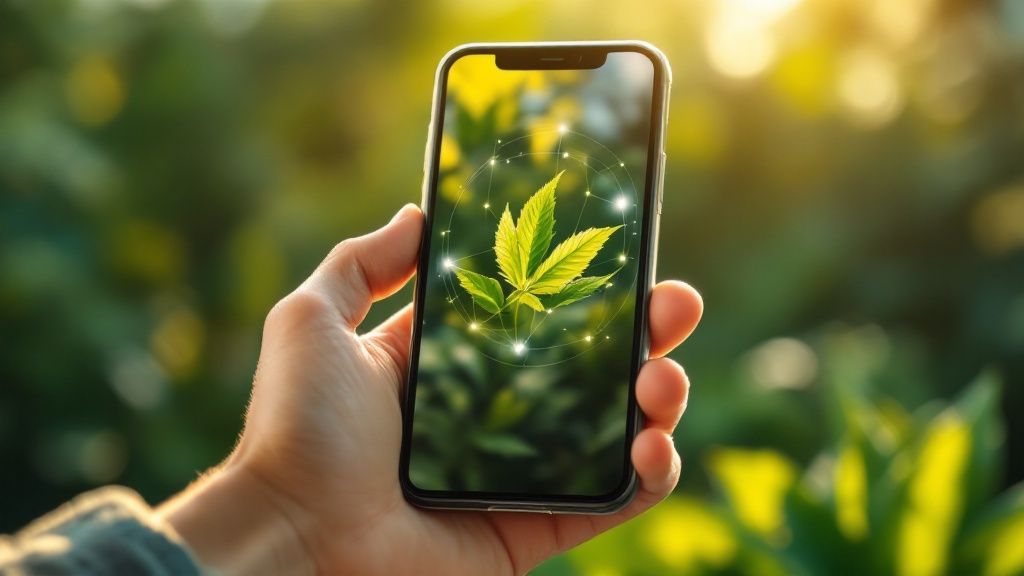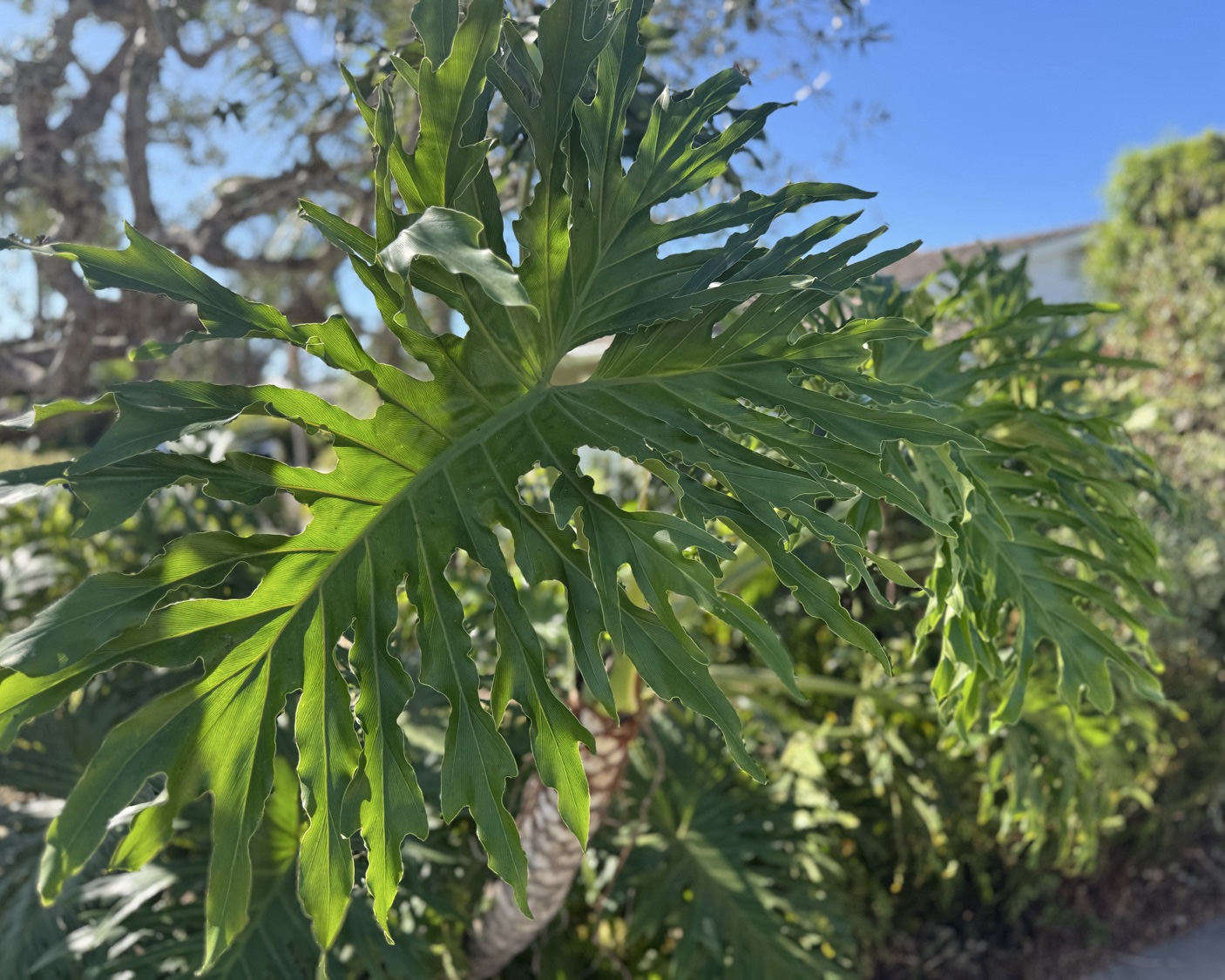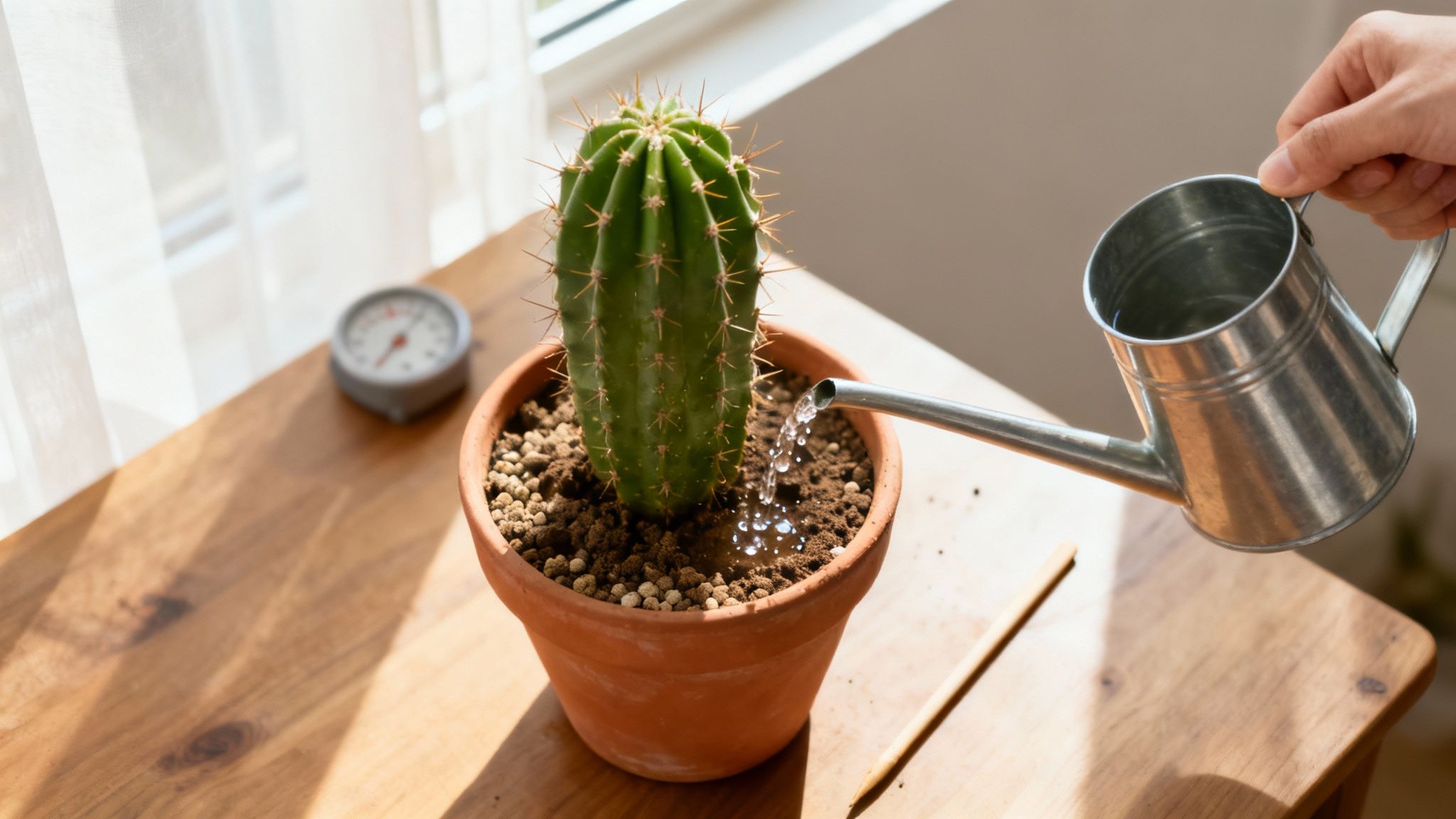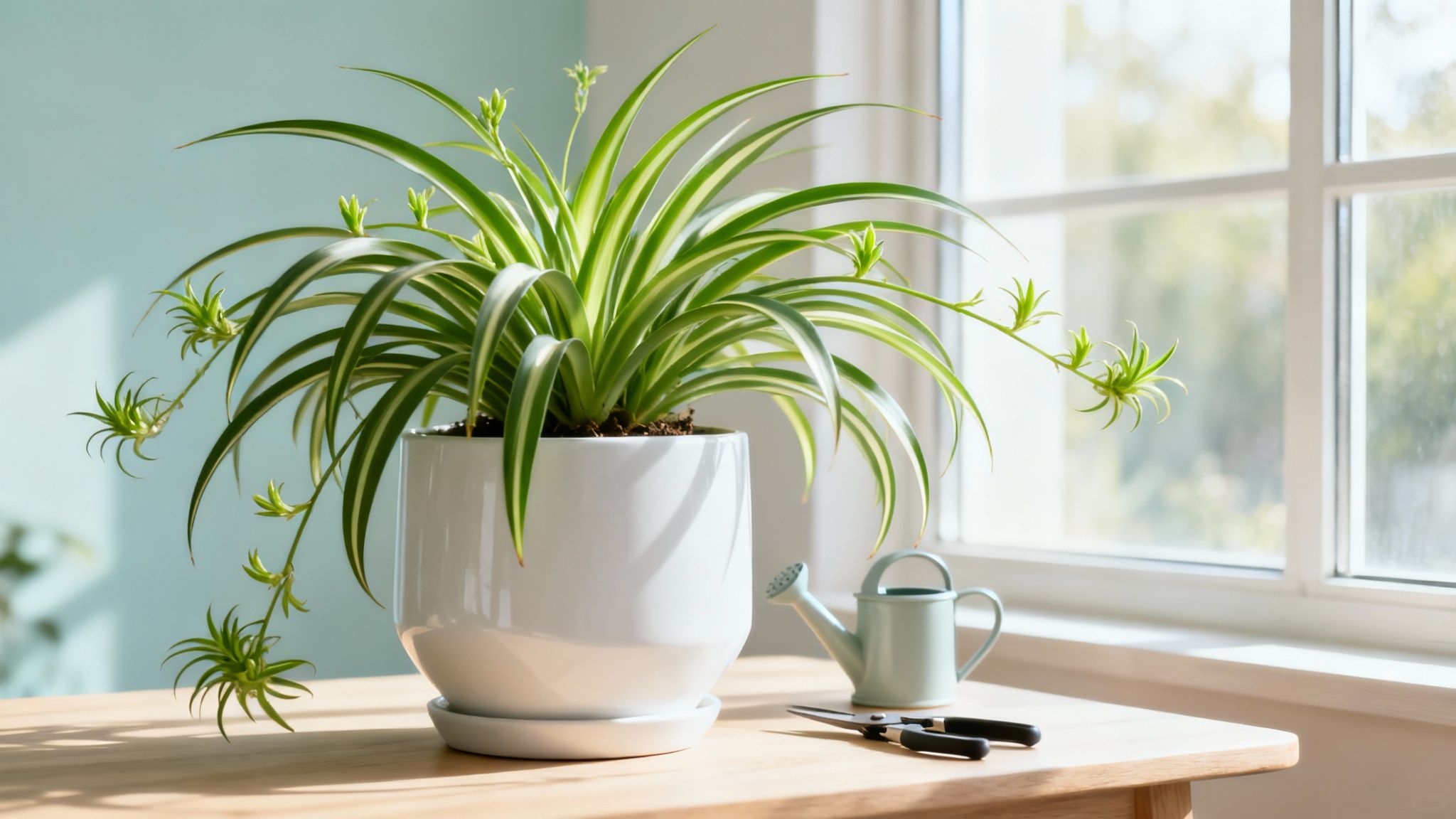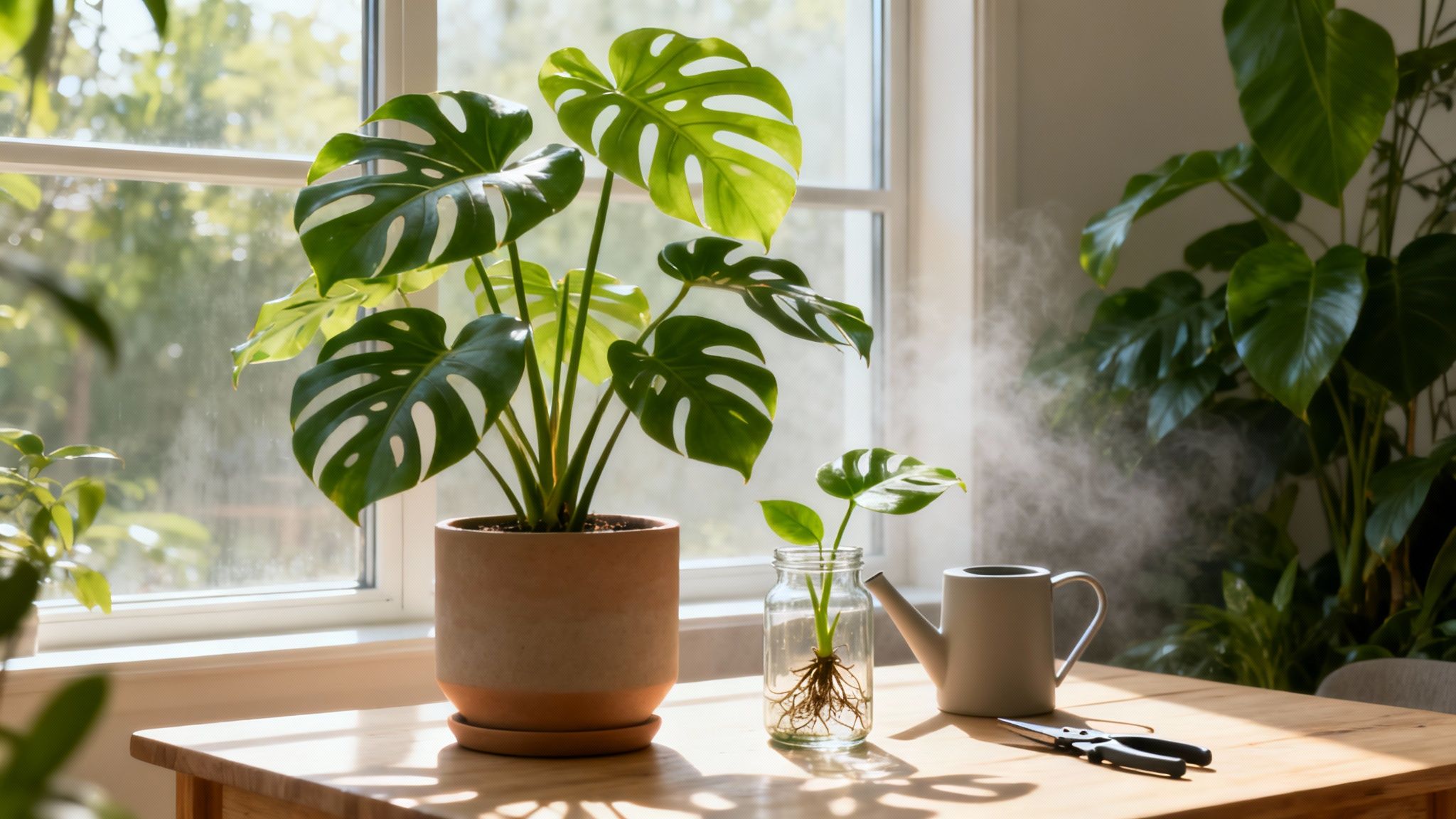Encountering an unidentified wildflower on a hike or receiving a nameless houseplant is a common curiosity for gardeners. A plant identification app can transform your phone's camera into a personal botanist, providing quick answers and care instructions while connecting you with a gardening community. This guide will assist you in selecting the right app to help your garden flourish.
Your Gardening Questions, Answered in a Snap

That flash of discovery—finding a volunteer seedling sprouting in your garden bed—is always exciting. But it immediately brings up a wave of questions. Is it a welcome guest or an invasive weed? Is it safe for my pets? And most importantly, how do I help it flourish?
Not too long ago, your only option was to spend hours flipping through dense field guides, hoping to find a match. Thankfully, technology now offers a much more direct path to that knowledge.
A great plant identification app doesn't just put a name to a leaf. It unlocks the plant's entire story and tells you exactly what it needs to thrive. Think of it as the first step in a rewarding journey of understanding and nurturing the green life around you.
With just a quick photo, you can learn everything from a plant's scientific name, like Monstera deliciosa, to its specific light, water, and soil needs. This is an absolute game-changer for new gardeners. If you're just starting out, our guide on how to start a garden is the perfect partner to the instant insights an app provides.
Apps like Tendra employ advanced AI with over 95% accuracy to transform plant identification from a guessing game into an enjoyable learning experience. Beyond simply identifying names, it builds confidence in delivering appropriate care and fosters connections with a community of like-minded plant enthusiasts. A key distinction is its capability to identify rare plants, not just the common varieties.
How Does a Plant Identification App Work Its Magic?
It feels magical, doesn't it? You snap a picture of a mysterious plant, and moments later, your phone identifies it using artificial intelligence (AI) and machine learning to analyze unique traits, much like having a botanist in your pocket.
What the AI Is Really Seeing
Upon uploading a photo, the app’s AI analyzes the image, creating a digital fingerprint by examining:
Leaf Shape and Arrangement: Identifying whether leaves are round, heart-shaped, or lobed, and their growth pattern on the stem.
Flower Color and Structure: Noting petal shade, number, and arrangement.
Vein Patterns: Recognizing unique vein networks akin to human fingerprints.
Bark Texture and Color: Assessing roughness, color, and pattern for trees and shrubs.
The AI then searches a vast database of verified plant images for a match, presenting it with a confidence score. The global plant identification app market is projected to exceed $1 billion by 2030 as this technology becomes more precise.
Why Data Quality Is Crucial
Competitors often only identify plants at the species level, missing distinctions like the difference between a Cherokee tomato and a beefsteak tomato or a navel orange and a Cara Cara orange. Tendra excels by specifying these differences and providing tailored care information.
An app’s accuracy depends on its database quality.
Tendra invests in expert-verified cultivar databases, identifying numerous varieties of vegetables, fruit plants and trees.
This ensures precise care information for your specific plant. Plus, the AI improves with each photo submitted, refining its accuracy. For more tips on improving results, check out our plant identification guides.
Beyond the ID: Features Every Gardener Needs
A basic plant identification app can tell you a plant's name, but that's just the starting point. The moment you learn you have a Fiddle Leaf Fig (Ficus lyrata), a dozen new questions pop into your head. Why are the leaves drooping? Does it need more sun? How much water is too much?
A truly great app anticipates what you'll need next, guiding you from simply naming your plant to helping it thrive. It becomes your go-to gardening companion long after that first ID.
Think of it like this: a simple app is a dictionary, but a comprehensive platform is an encyclopedia, a doctor, and a personal calendar all rolled into one.
Proactive Plant Health and Care
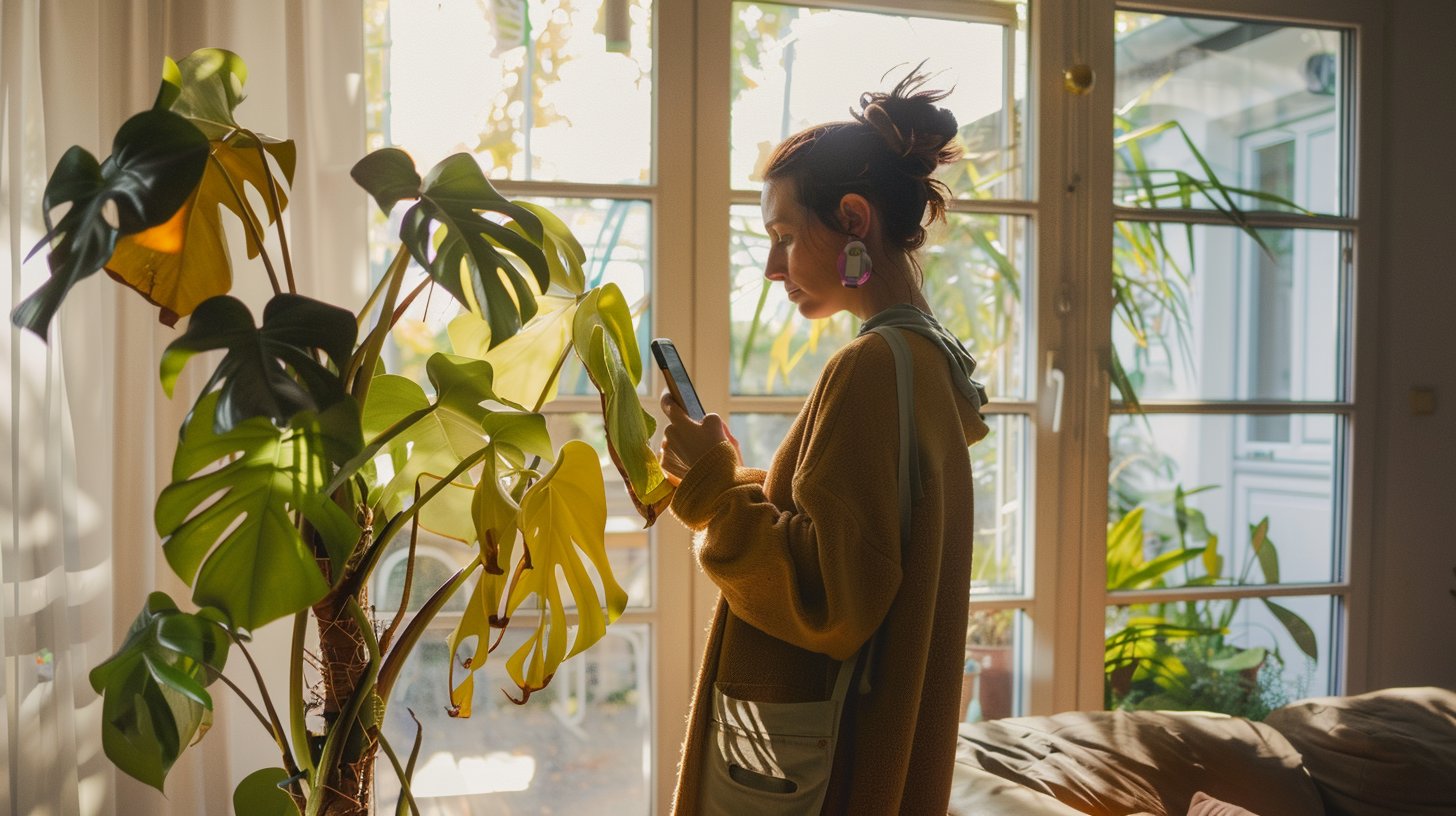
Imagine you spot a weird yellow blemish
on your prize-winning monstera plant. Your first instinct might be to panic-search online forums, sifting through conflicting advice. This is where an integrated app changes the game.
ame.
A comprehensive app acts as your garden's first line of defense. It helps you spot potential problems early and provides clear, actionable steps to keep your plants healthy.
This is the real power of features like AI Disease Diagnosis. You just snap a picture of the troubled leaf, and the app’s AI analyzes the patterns to pinpoint potential diseases or pests, then offers effective, often organic, treatments. It's like having a plant pathologist on call.
Then there are Smart Care Reminders. A sophisticated app like Tendra lets you create a personalized schedule based on your specific plants and local climate. You’ll get a friendly nudge when it’s time to water, fertilize, or prune, ensuring every plant gets exactly what it needs, right when it needs it.
Getting Into the Weeds: Detailed Variety Info
For the passionate gardener, "tomato" is just not enough detail. You want to know if you're growing a 'Brandywine' tomato, with its specific flavor profile, or a 'San Marzano' that's perfect for sauces.
This is where a deep database of plant varieties becomes invaluable. Here’s what a great app should provide:
Fruit Specifics: Notes on sweetness levels, flavor profiles, and the best time to harvest.
Growth Habits: Details on a plant's mature size, how much sun it needs, and whether it’s suited for your climate zone.
Pollination Needs: Crucial info on whether a variety is self-fertile or needs a partner plant nearby to produce fruit.
This demand for deeper information is fueling incredible growth. The plant identification app industry pulled in around USD 1.2 billion in a single year and is on track to hit USD 3.5 billion by 2033. You can dig into the numbers yourself by checking out the full market analysis.
Comparing Essential Features in a Plant Identification App
Feature | Basic Plant ID App | Comprehensive App (Tendra) | Why It Matters for You |
|---|---|---|---|
Identification | Basic species name | Detailed variety and cultivar info | Know exactly what you're growing for precise care. |
Care Guides | Generic, one-size-fits-all tips | Personalized care plans and reminders | Get advice tailored to your specific plant and climate. |
Health Diagnosis | Limited or non-existent | AI-powered disease & pest detection | Quickly solve problems before they harm your plants. |
Community | User forums, often unmoderated | Local gardening networks and expert connections | Access reliable advice from seasoned local gardeners. |
Garden Management | No features | Digital garden planner and progress tracker | Organize your garden and see your plants' history. |
While a basic app is handy for a quick ID on a hike, a comprehensive tool like Tendra is built for the dedicated gardener who wants to see their plants flourish.
The Power of Community: When an App Isn't Enough
AI identification is a fantastic starting point, but technology has its limits. An app can tell you that you have a Lemon tree (Citrus limon), but it can’t tell you why the lemons on your specific street are getting hit by a hyper-local pest that just showed up this season. This is where the secret weapon for successful gardening comes in: people.
True garden wisdom is almost always local. It’s the knowledge that accounts for your city's quirky microclimates, your neighborhood's soil type, and the exact challenges gardeners are facing right where you live. Technology gives you the "what," but a community provides the "how" and the "why."
Beyond the Algorithm: Real-World Wisdom
While a plant identification app gives you a crucial piece of the puzzle, some problems need a human touch. Shared experience is something technology alone can't replicate.
Consider these real-world scenarios where local knowledge is gold:
Pest Outbreaks: A fellow gardener two blocks away can give you a heads-up about an aphid explosion before it finds your roses.
Weird Weather: When an unexpected late frost is in the forecast, local experts can share their tried-and-true methods for protecting delicate plants in your specific USDA Hardiness Zone.
Sourcing Plants: Desperate for a rare 'American Beauty' dragon fruit cutting? Someone in your local network might be willing to trade or share.
This is why we built Tendra to be more than just an identification tool; it's a living network. It closes the gap between raw data and what actually works in your garden, connecting you with people who have already solved the problems you’re facing today.
Finding Your Twin Plant Mates
One of the most powerful features inside Tendra is the Twin Plant Mates network. This isn't just another generic forum. It’s a targeted system that connects you with other gardeners in your area who are growing the exact same plant varieties as you.
Imagine being instantly connected with a dozen local gardeners who are also trying to get their 'Celeste' fig trees (Ficus carica 'Celeste') to produce fruit. That kind of shared, specific experience is something no algorithm can reproduce.
This feature shifts gardening from a solo hobby into a team sport. You can compare notes on growth rates, celebrate successes, and troubleshoot problems with people who know exactly what you're dealing with. The Plant Exchange Marketplace also creates a buzzing local economy for gardeners, helping you find and share plants that are already thriving in your climate. By mixing powerful AI with an active, local community, you get the best of both worlds.
A Real-World Example: Alex's Austin Garden
Let's follow the story of Alex, a new homeowner in Austin, Texas (USDA Zone 8b). Alex was excited about having a yard but overwhelmed by mystery plants and the dream of starting a fruit garden.
First up was a mystery shrub. Instead of hours in gardening books, Alex snapped a photo with Tendra. Instantly, the app identified it as a Texas Sage (Leucophyllum frutescens)—a gorgeous, drought-tolerant native. Puzzle solved.
Next, Alex spotted strange yellowing on a small citrus tree. Problem: was it a pest, a disease, or a nutrient issue? Using the AI Disease Diagnosis feature, Alex uploaded a picture. The app quickly suggested a probable iron deficiency, a common problem in Austin's alkaline soil, and laid out a clear plan to fix it.
Feeling more confident, Alex decided to add a fig tree. But which kind would survive the Texas heat? Diving into Tendra’s extensive cultivar database, Alex compared figs known for thriving in hot climates and landed on a 'Celeste' fig—famous for its heat tolerance. For more tips on picking plants, check out our in-depth guides.
Finally, Alex needed local wisdom on protecting that young tree from unpredictable weather. Using the Twin Plant Mates feature, Alex connected with another gardener just a few miles away who had been growing 'Celeste' figs for years. This hyper-local advice on winter protection and pruning was invaluable.
Choosing the Right Plant Identification App for You
Picking the right plant identification app is like choosing a good gardening buddy. The secret is to look for more than a simple name-tag feature. You want a tool that grows with you.
The best app isn't just a digital field guide; it's a full support system. Highly accurate identification is the bedrock. An app that can't tell a 'Hass' avocado from a 'Fuerte' will leave you with vague, or even wrong, care advice.
More Than Just a Name
Once you get that accurate ID, what happens when things go wrong? Look for these game-changing features:
AI Disease Diagnosis: Instantly get clear advice on pests and diseases to stop small problems from becoming big headaches.
Smart Care Reminders: Personalized reminders for watering and feeding take the guesswork out of your routine.
Deep Cultivar Databases: For serious gardeners, specific info on flavor, climate suitability, and pollination is non-negotiable.
Choosing an app isn’t just about figuring out what’s in your garden now. It’s about empowering yourself to successfully grow whatever you dream of planting next.
The Power of People
At the end of the day, technology can only get you so far. An app that keeps you isolated is missing the most crucial piece of the puzzle. The best plant identification app should also be a bridge, connecting you to a network of people who understand your specific climate and challenges.
This is where Tendra stops being just an app and becomes your gardening command center. It blends high-accuracy AI with features like Twin Plant Mates, putting you in direct contact with growers in your neighborhood. It’s built on the idea that the best advice often comes from a neighbor who has already solved your exact problem.
By bringing together precise technology and a living, local community, you get a partner that helps you connect—with your plants, and with fellow gardeners. Discover a smarter way to grow with Tendra, where local gardeners connect and thrive.
